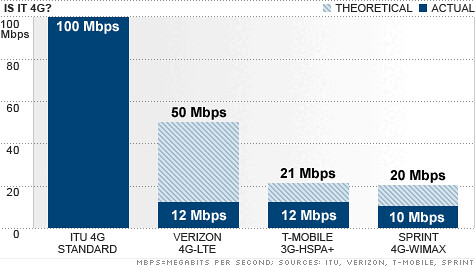Everywhere you go, advertisements for 4G networks are sprouting up all over the place. From Verizon to Spring, one would think that 4G supersonic speeds are not only right around the corner, but are already available in select US cities.
Not so fast.
The International Telecommunication Union (ITU) ruled a few weeks ago that 4G is officially defined as a network capable of download speeds of 100 Mbps – fast enough to download an HD movie in approximately 3 minutes.
So what about those 4G networks systematically being rolled out by Verizon and co.? Well, the comparison isn’t even close.

So what’s up with the 4G moniker, then?
Here’s the backstory, courtesy of David Goldman of CNN Money:
Sprint bought a majority stake in Clearwire, which uses a new network technology called WiMAX that’s capable of speeds ranging from 3 Mbps to 10 Mbps. That’s a different technology from Verizon’s new network, based on a standard called Long Term Evolution (LTE), which will average 5 Mbps to 12 Mbps.
Seeing what its competitors were up to, T-Mobile opted to increase the speed capabilities of its existing 3G-HSPA+ network instead of pursuing a new technology. Its expanded network — now called 4G — will reach speeds of 5 Mbps to 12 Mbps.
No matter what they’re called, all of these upgrades are clear improvements — and the carriers shelled out billions to make them. Current “3G” networks offer actual speeds that range from between 500 kilobits per second to 1.5 Mbps.
So Sprint and Verizon have new, faster networks that are still technically not 4G, while T-Mobile has an old, though still faster network that is actually based on 3G technology.
Confused yet? That’s why they all just opted to call themselves “4G.”
And we’re not complaining, really. I mean, as long as networks continue to support faster speeds, who are we to complain if they meet the official definition of a UN governing body?





December 9th, 2010 at 3:22 pm
Completely separate from the ITU standards issue, T-Mobile has gone and mucked the whole thing up by calling their 3G-based HSPA+ network “4G”. AT&T is also rolling out HSPA+, but not calling it 4G, as it’s an incremental improvement to the existing 3G network.
So we’ve got T-Mobile and AT&T basically operating identical networks, with one of them calling it “3G” and one of them calling it “4G”.
Thanks, marketing folks.